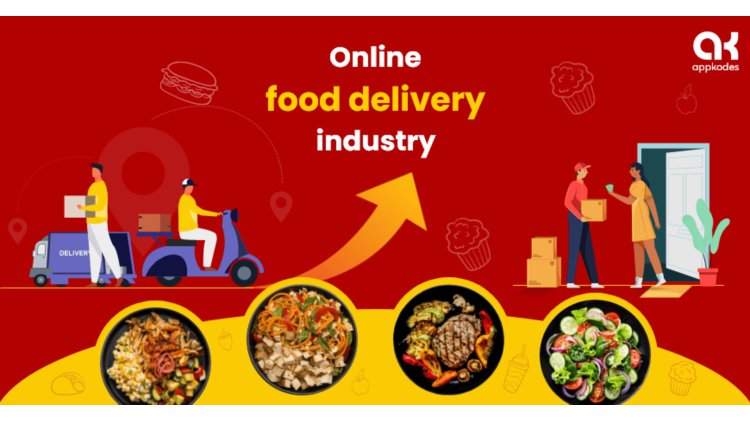What Top Food Apps Won’t Tell You About Their Success—But We Will!
Uncover the real strategies that make food delivery apps like Uber Eats thrive. From smart UX design to hyperlocal tactics and AI-driven insights, learn how to build a successful platform with the help of experts like Appkodes.

“Success leaves clues, but not everyone shares the recipe.” The food delivery industry is booming, but have you ever wondered why some food apps thrive while others quietly disappear? There’s more to the story than just offering great food and fast delivery. The secret lies in the strategies that top food apps use to dominate the market secrets they don’t openly share. If you’re looking to develop a high-performing food delivery platform, partnering with a reliable Food Delivery App Development Company is crucial. Companies like Appkodes provide cutting-edge solutions to help businesses create scalable and successful food apps.
Why Food Apps Are Thriving
The global food delivery market is projected to exceed $320 billion by 2029. Convenience, digital payments, and changing consumer habits have fueled its rapid growth. Giants like Uber Eats, DoorDash, and Zomato have revolutionized how people order food, but their success isn’t just luck—it’s a combination of smart strategies, technology, and innovation.
So, what exactly makes these food apps successful? Let’s dive into the lesser-known factors that determine whether a food delivery app thrives or fades away.
1. The Psychology of Ordering: Why People Keep Coming Back
Successful food apps leverage behavioral psychology to keep customers hooked.
Tactics They Use:
- Personalized Recommendations – Using AI to suggest dishes based on past orders.
- Scarcity & Urgency – Limited-time deals create a fear of missing out (FOMO).
- Gamification – Loyalty programs with rewards encourage repeat orders.
- Convenience Triggers – One-click reordering makes ordering effortless.
Food apps don’t just sell meals; they sell experiences. The easier and more engaging the process, the more frequently users order.
2. A Business Model That’s Built to Last
Many food delivery startups fail because they don’t structure their revenue models effectively. Top apps rely on multiple income streams.
Successful Monetization Strategies:
- Commission Fees – Charging restaurants per order.
- Delivery Fees & Surge Pricing – Adjusting prices based on demand.
- Subscription Plans – Offering free deliveries for members (e.g., Uber One).
- Advertising & Promotions – Paid visibility for restaurants on the platform.
Without a sustainable revenue model, even a well-designed app can collapse.
3. The Secret Sauce: Hyperlocal Expansion Strategies
Most food apps fail when they expand too fast without understanding local markets. Top food delivery apps adapt their strategies for different regions.
How They Win Locally:
- Partnering with Popular Local Restaurants – Creating trust and familiarity.
- Offering Regional Cuisines – Catering to unique food preferences.
- Localized Promotions & Discounts – Engaging local audiences effectively.
Apps that successfully localize their approach grow faster and gain loyal users.
4. The Hidden Role of AI & Data Analytics
Successful food delivery apps don’t just guess what users want; they use data analytics and AI to make informed decisions.
How AI Powers Food Apps:
- Predictive Demand Forecasting – Reducing wait times by anticipating high-demand hours.
- Smart Route Optimization – Cutting down delivery times.
- Customer Sentiment Analysis – Monitoring feedback for service improvements.
These technological advancements allow top food apps to provide smoother and more efficient services, setting them apart from competitors.
5. The Importance of UX/UI Design
A poorly designed app will drive users away, no matter how great the food selection is. Leading food apps invest heavily in their user interface (UI) and user experience (UX) design.
Essential UX/UI Features:
- Minimal Steps to Order – Reducing friction in the buying process.
- Real-Time Order Tracking – Enhancing transparency and customer satisfaction.
- Multiple Payment Options – Including digital wallets, BNPL (Buy Now, Pay Later), and crypto.
- One-Tap Customer Support – Ensuring quick problem resolution.
6. The Role of Marketing: Selling More Than Just Food
Top food apps don’t rely solely on word-of-mouth. They execute aggressive and innovative marketing campaigns to attract and retain customers.
Winning Marketing Strategies:
- Influencer Collaborations – Partnering with food bloggers and social media influencers.
- Referral Programs – Offering discounts for bringing in new users.
- Flash Sales & Limited-Time Offers – Encouraging spontaneous orders.
- Push Notifications & Email Campaigns – Keeping customers engaged.
Marketing isn’t just about promotions; it’s about staying top-of-mind with consumers
7. Why Some Apps Fail While Others Flourish
For every success story, there are hundreds of failed food delivery apps. The biggest mistakes include:
- Lack of Scalability – Poor infrastructure that crashes during peak hours.
- Ignoring Customer Service – Failing to address complaints and refund requests.
- No Unique Selling Proposition (USP) – Not standing out in a crowded market.
- Unsustainable Pricing Models – Losing money on each order.
Avoiding these pitfalls can mean the difference between thriving and failing.
Final Thoughts: The Future of Food Delivery Apps
The food delivery industry is evolving, with new trends like drone deliveries, ghost kitchens, and blockchain food tracking gaining traction. Businesses looking to enter this space need to invest in technology, user experience, and market-specific strategies to stay competitive.
If you’re planning to build a food delivery app, choosing the right Food Delivery App Development Company is essential. With years of expertise in building high-performance food apps, Appkodes provides robust and scalable solutions that help businesses stay ahead of the curve.
Are you ready to create the next big food delivery platform? Take the right steps, leverage industry secrets, and ensure your app stands out in this fast-growing industry!
What's Your Reaction?

















.jpg)
.jpg)

